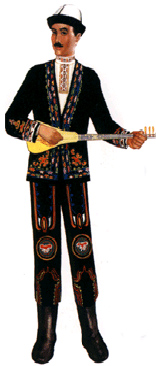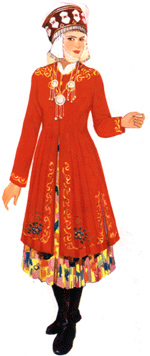|
Kirgiz's Costume
( 2005-09-13 )
 The Kirgizs, with a population of 140,000, mainly live in the Kizilsu Kirgiz Autonomous Prefecture of Northwest China'sXinjiangUygur Autonomous Region. For hundreds of years, the Kirgizs have led a nomadic life. Although still nomadic, today they also farm. The Kirgizs have their own language. Being Muslim, the Kirgizs have a rich legacy in poems, stories, proverbs, and fables. The Kirgizs, with a population of 140,000, mainly live in the Kizilsu Kirgiz Autonomous Prefecture of Northwest China'sXinjiangUygur Autonomous Region. For hundreds of years, the Kirgizs have led a nomadic life. Although still nomadic, today they also farm. The Kirgizs have their own language. Being Muslim, the Kirgizs have a rich legacy in poems, stories, proverbs, and fables.
The Kirgiz women are good at embroidery andpaper cutting. Tapestries on the walls and carpets on the floors are all woven by the Kirgiz women and the designs bear a rich flavor of their distinct ethnic characteristics.
 The Kirgiz men usually wear a blue or black sleeveless long gown made of sheepskin or cotton cloth over a white round-collared shirt with embroidered laces. Some wear a collarless long gown made of camel hair and laced with black cloth around the cuffs. They hang a small knife or flint on their leather belts, and often put on leather trousers and boots. They look very brave in their costumes. The Kirgiz men usually wear a blue or black sleeveless long gown made of sheepskin or cotton cloth over a white round-collared shirt with embroidered laces. Some wear a collarless long gown made of camel hair and laced with black cloth around the cuffs. They hang a small knife or flint on their leather belts, and often put on leather trousers and boots. They look very brave in their costumes.
People of theKirgiz ethnic minority, no matter young or old, male or female, all wear a green, blue, purple, or black round-topped little cap made of corduroy, and a terai (a high-topped leather hat with a wide brim) in all seasons.
Kirgiz women wear a wide collarless jacket buttoned down the front and a black waistcoat or a collarless long gown over the jacket. Young women love to wear a red dress and cap alongside a red or green handkerchief tied around their head; old women prefer to wear a white handkerchief. In addition, the women like to wear high-embroidered boots. Unmarried girls do their hair into braids, decorated with silver chains and beads; once married, they will have only two braids.
|

